No 14 - 2014
Whooping cough 2013
Whooping cough in children below 2 years of age
Whooping cough 2013
This report comprises all cases of laboratory-diagnosed whooping cough detected in Denmark in 2013, by culture, PCR or serology.
A total of 484 cases of whooping cough were detected in 2013. The overall incidence was 8.6 per 100,000; a decrease compared with the 2012 incidence. The number of cases and incidence per area in 2012 and 2013 is presented in Table 1.
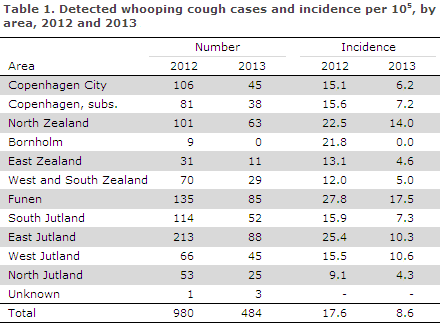
Age and gender
Table 2 shows the distribution by age and sex and age-specific incidence.
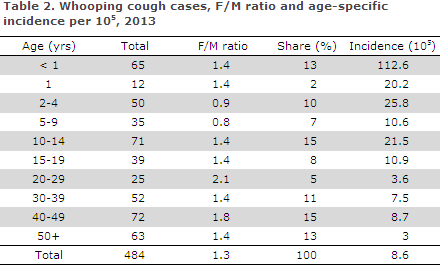
In line with previous years, the highest incidence was observed among 0-year-olds and among 2-4-year-olds and 10-14-year-olds. A small excess incidence was seen among women/girls in nearly all age groups.
Diagnostic method
As in previous years, PCR was the most frequently used method, comprising 75% of the total number of detected whooping cough cases. Serology comprised 25% of the detected cases, and culture 0.6% with only 3 detected cases.
Serology can only be used to diagnose patients above 7 years of age. Serology is particularly well-suited for diagnosis of adults, which is reflected in the distribution showing diagnostic method by age, Figure 1. PCR and serology complement each other, as PCR can be employed only in the beginning of the disease course, whereas serology can be used only after a few weeks with symptoms.
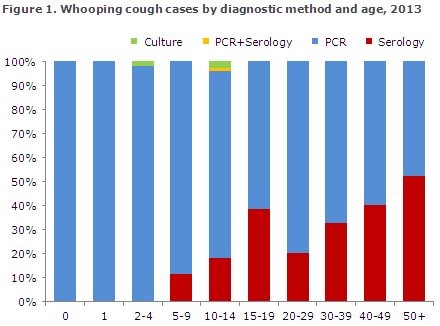
Figure 2 reveals that the increase observed in 2012 levelled out in the first few months of 2013. No significant signs of seasonal variation were seen. Figure 2.
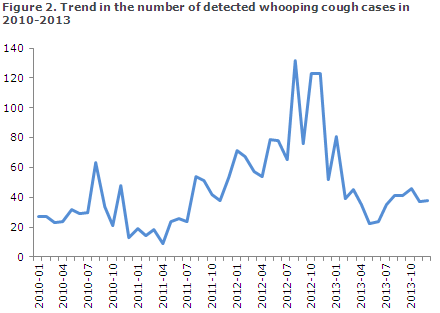
Commentary
In 2013, the whooping cough incidence decreased to 8.6 per 100,000, which was at par with the incidence observed in the 2007-2011 period (7-10 cases per 100,000). In 2012, an increased incidence of 18 cases per 100,000 was observed, EPI-NEWS 15/13. The most recently observed whooping cough epidemic in Denmark occurred in 2002, at which time the incidence reached 36 per 100,000.
Whooping cough occurs most frequently among 0-year-olds because these infants are not fully vaccinated at 3, 5 and 12 months of age (see below for more information). Immunity after vaccination is assessed to last for 4-12 years, and the relatively high incidence among teenagers is due to the fact that immunity after revaccination at 5 years tapers off for this age-group. Some countries have introduced teenage vaccinations, but, presently, Denmark has not.
In recent years, the number of whooping cough cases among adults has been increasing steadily. This is probably owed to an increased awareness that whooping cough is not just a childhood disease and an associated growing diagnostic attention to whooping cough in adults. The introduction of serology as a diagnostic method has also made it possible to detect whooping cough later in the disease course - i.e. at a time when adults typically see a doctor, e.g. due to prolonged coughing.
2013 saw a small excess incidence of cases in women/girls. In previous years, the gender distribution among children was more even. Previously, a higher number of female cases were also seen. There is no obvious biological explanation for this, but it may be associated with the fact that women have more contact with small children and that women are more likely to see their doctor than men are.
(T. Dalby, Microbiology and Infection Control, L.K. Knudsen, P.H. Andersen, Department of Infectious Disease Epidemiology)
Whooping cough in children below 2 years of age
In children below 2 years of age, whooping cough is individually notifiable. Form 1515 is to be used in laboratory-confirmed cases.
2013 saw a total of 73 notified cases of whooping cough in children below 2 years of age, including 62 (85%) children below 12 months of age. Overall, 42% were boys and 58% girls. In 2013, reminders were sent out for 25% of the notifications. Small differences between the number of laboratory-confirmed and notified cases < 2 years are caused by different registration and reporting procedures at year’s end.
Among the 73 notified children below 2 years of age in 2013, 28 (38%) were unvaccinated, whereas 6 (8%) had received three whooping cough vaccinations in the form of DTaP-IPV/Hib.
Admission and sequelae
Among the 73 notified children notified in 2013, a total of 45 children (62%) were admitted for one or more days. Among the youngest infants below 3 months of age, a total of 14 (79%) infants were admitted for one or more days, Figure 3.
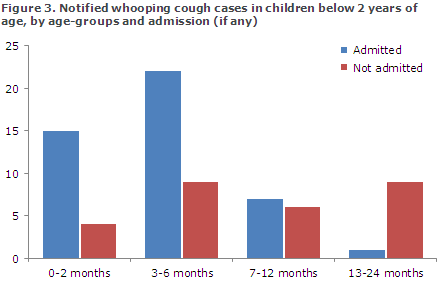
Based on notifications and/or discharge summaries, no fatalities were recorded due to whooping cough in 2013, but according to a notification, one child suffered from severe pneumonia and required respiratory support.
Transmission
In 2013, the source of infection was known in 53% of the notified cases in children. Siblings and other household members were the presumed source of infection in 47% of cases.
Commentary
In 2013, the occurrence of whooping cough in children under 2 years of age was more than halved compared with 2012 (155 cases) and at par with the occurrence observed in 2010-2011.
Timely whooping cough vaccination of infants in the form of DTaP-IPV/Hib is essential as significant protection against whooping cough is only achieved after two vaccinations. The recommended vaccination times at 3, 5 and 12 months of age should be followed to the extent possible. Furthermore, a DTaP-IPV booster is recommended at 5 years of age.
In unvaccinated or partly vaccinated children < 2 years who are exposed to whooping cough, antibiotic prophylaxis should be considered in accordance with the guidelines described in EPI-NEWS 41/12. Health personnel may constitute an infection risk, particularly to smaller children.
(L.K. Knudsen, P.H. Andersen, Department of Infectious Disease Epidemiology)
Link to previous issues of EPI-NEWS
2 April 2014